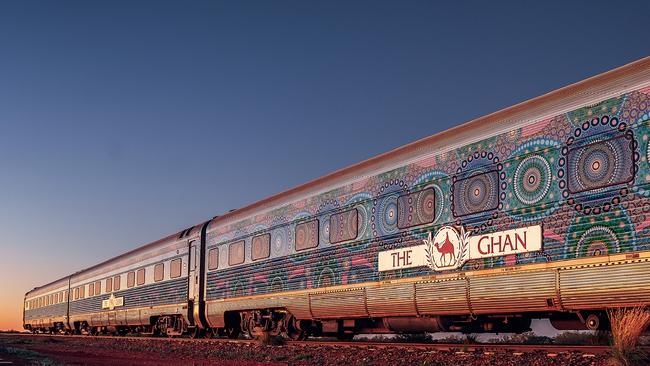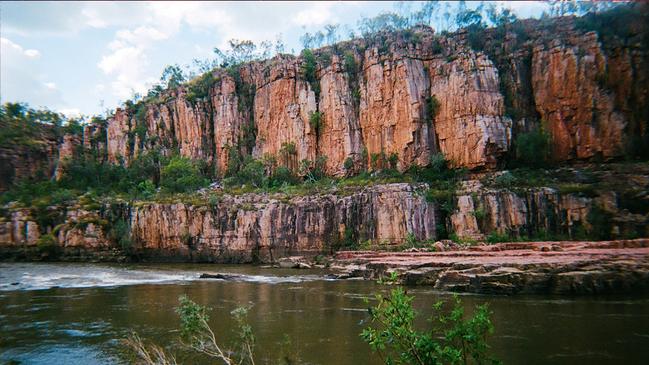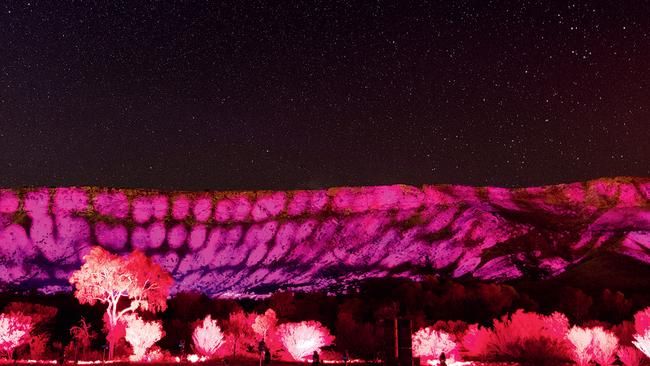The Ghan: An epic journey to the red centre, like you’ve never seen it before
Brimming with untapped adventure and ancient tales, travelling on The Ghan to one of the country’s most unique festivals more than delivers.

In the dead of night, in the middle of the desert, The Ghan slows from 115 km/h to a surprisingly gentle stop, for a 1,760-tonne train. There is a wheezing exhale of the engine and then descendant silence; pin-drop quiet that is hard to find anywhere in the world.
We are somewhere between the Tanami and Simpson Deserts where no headlights or highway penetrate and, for now, the halt is unexplained. Where savannah gives way to arid mulga-studded plains, the nearly kilometre-long train is a mere dot along the 2,973-kilometre tracks that cleaves the continent in half from Darwin to Adelaide.
The legendary Australian train is making a special journey from the northern capital to the Red Centre for Parrtjima, the unique annual festival of light and culture showcasing Indigenous art, a piece of which, by Arrernte artist Chantelle Mulladad, has been applied impressively to the train’s exterior to celebrate the journey. The train, the flagship of rail expeditions by Journey Beyond, is so-named after migrant Afghani cameleers who ferried goods on their camels, or ‘ships of the desert’ to railway workers and remote settlements in the 1860s.
This modern ship of the desert is, however, decidedly more comfortable. It is April, and it could be as cold as 12-degrees Celsius outside, but inside the cocooning cabin and plump single bed, it is hard to tell. A look outside, and the pan-flat horizon is barely visible through the inky darkness illuminated by a swathe of stars.
The solitude – and it is a breathtaking kind, felt peering through the window into the ether – is surprisingly welcome, in a year when one may think isolation is the last thing anyone’s after.
In fact, through Covid, the train has taken on new appeal. Though its carriages are at close quarters, it is divided up so that each dining and bar car is shared by only a handful of accommodation cars. It is impervious to the pace of the city, and happily, for workaholics, beyond the reach of reliable 4G. The pace is meditative and, while watching the three-metre-tall spear grass flit by or the sun set over the baked earth, aperitif in hand, the appeal of train travel reveals itself.

In a car, distracted by driving or navigation or slowed by traffic, there is no rhythm. From a plane, distance is abstract from up so high. This is travel on a human scale, allowing time to contemplate in a chaotic moment.
Alighting the day before at the semi-tropical Katherine hints at the hidden dimensions of this journey. Boarding a steel boat, we float down Nitmiluk, or Katherine Gorge, a place shared by saltwater crocodiles who slide into the water from the sandy beaches lined with native passionfruit and pandanus. We trace the path of Nabilil, a figure of the Creation Time, who heard the “Nit! Nit! Nit!” of cicadas, and christened it thus.
The national park here is owned by the Jawoyn people and run in partnership with the Northern Territory Parks and Wildlife Commission. At its deepest, the water is 40 metres, pooling where the Rainbow Serpent is said to have carved a place to rest. This corner is sacred, off-limits to pregnant Jawoyn women, and verboten for Jawoyn people to touch its waters.
Back on the train, it is a reminder that we have been traversing rail, yes, but ancient songlines, too. Early the following morning, and The Ghan is scudding its way through the landscape dotted with termite mounds like crooked witches’ hats glowing blood red in the light. The crew inform us of the cause of the midnight stop: a freight train had broken down coming from the other direction, and a passing had to be negotiated.
Pulling into Alice Springs just after 9 o’clock and the brut tectonic force that formed the rise of the MacDonnell Ranges is on show; a mountain range that was once the height of the Himalayas, worn down by ancient elemental forces. They provide the backdrop, literally, for Parrtjima.
Beginning in 2016, the spectacle is described as a festival of lights, and each year the cornerstone is a light and sound show projected onto a gargantuan two-kilometre stretch of the ranges, this time soundtracked by electronic outfit Electric Fields.

Held in Desert Park, light installations showcase artwork from emerging and established Indigenous artists in a meeting point of contemporary application and millennia-old stories. To achieve this, a team including curator Rhoda Roberts, work with a reference group of native title holders from Mparntwe (Alice Springs) who, each year, consult to ensure the results are culturally sensitive. This year the theme is Future Kultcha.
“Because without our next generation, our language, our story, our song won’t continue,” Roberts tells the gathered crowd on opening night. “That intergenerational transmission of knowledge is so important.”
The roster of films, talks, presentations and food is a holistic program designed for, “getting to know us one-on-one”, says Roberts. It is accompanied by an installation curated by writer and creative Nina Fitzgerald, who is also hosting a print-making workshop.
On show in Todd Mall, the former is a showcase of textile art from First Nations makers around the county, including the bold graphic florals of Esmae Bowen of Hope Vale Arts in Queensland, and the concentric circles of Emily Kaybbrimm’s Brolga Eggs.
Fashion, as Fitzgerald sees it, is also a way to share and honour the diversity of Indigenous cultures.
“Everyone wears clothes and engages with fashion every single day. So I think that excites people, because it’s a pretty contemporary medium,” she says. “[It’s] changing people’s perception. What is Aboriginal Australia today? Today it looks like so many things.”

On the final Parrtjima night is Merne, or desert dinner, a showcase of Indigenous ingredients, accompanied by guided stargazing. We sample native basil, pepperberry and smoked roo – all mouth-watering – while spotting supernovas and contemplating the Milky Way. First glimpsed in full blaze on that midnight train stop, the astronomer explains that in some Indigenous lore its milkiness is seen as smoke from fires, while the Southern Cross is a stingray, followed by sharks – the pointer stars.
As we digest our quandong tarts, he reminds us that stars are so distant they are often gone before the light reaches us on earth. “You’re seeing things as they were,” he says, “not as they are.” And, via luminous light shows like a portal to the past and a long-form journey through an ancient landscape, it’s hard not to think he is right.
Parrtjima returns April 8 to 17, 2022 with a theme of Sky Country and a full program to be announced next month.
Go to parrtjimaaustralia.com.au and journeybeyondrail.com.au.
This article appears in the January issue of Vogue Australia, on sale January 6.

To join the conversation, please log in. Don't have an account? Register
Join the conversation, you are commenting as Logout